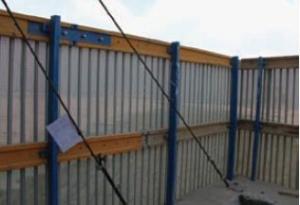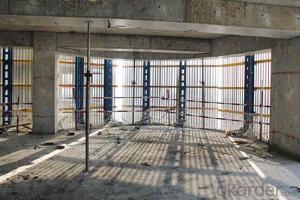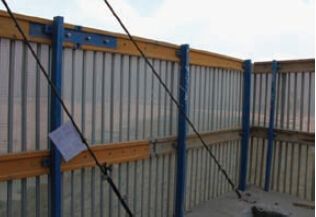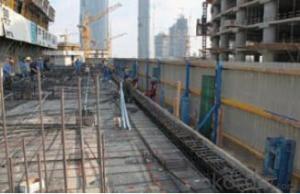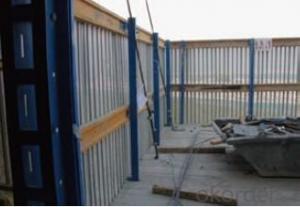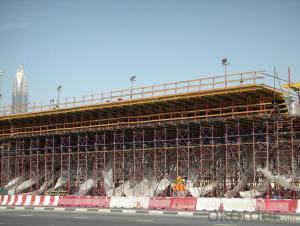Protection Platform for Formwork and Scaffolding build
- Loading Port:
- Tianjin
- Payment Terms:
- TT OR LC
- Min Order Qty:
- 50 m²
- Supply Capability:
- 1000 m²/month
OKorder Service Pledge
OKorder Financial Service
You Might Also Like
Protection Platform PP-50
A kind of new type construction protection system, applying operating platform and safer job
location for construction corps.
Characteristics:
◆ Easy and quick assembling.
◆ Lifted as a group, it is rapid and economic.
◆ Auto-climbing
◆ A safe and reliable anchor system
1. Composition
2. Assembly process of anchor system
(1) Embed V-climbing cone and anchor plate into the slab.
(2) Fix anchor shoe on the slab by tensile bolt.
(3) The fixed anchor shoe.
◆ High work efficiency with work platform and unload platform
◆ High light transmittance with the hollow block
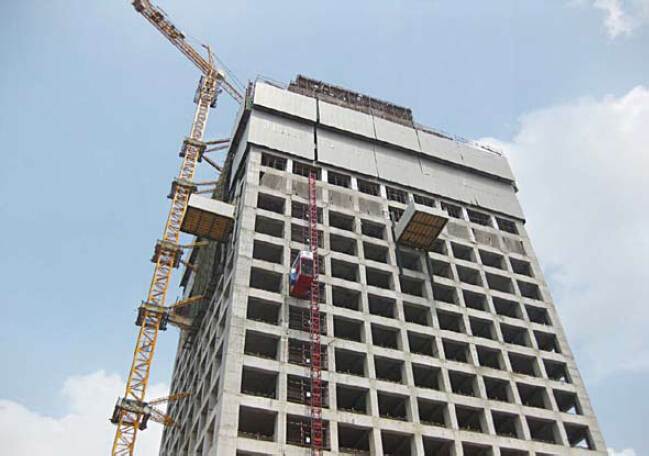

- Q: How does steel formwork contribute to the overall speed of construction?
- Steel formwork contributes to the overall speed of construction in several ways. First and foremost, steel formwork is known for its high strength and durability, allowing it to withstand the pressure and weight of wet concrete. This means that construction teams can pour concrete into the formwork and proceed with the next steps of the construction process without having to wait for the concrete to fully cure or harden. As a result, this significantly reduces the overall construction time. Additionally, steel formwork is highly reusable, which further enhances the speed of construction. Unlike traditional timber formwork, which needs to be replaced after a few uses, steel formwork can be used multiple times without compromising its structural integrity. This eliminates the need for constant formwork preparation and allows construction crews to quickly move from one section to another, saving both time and resources. Moreover, steel formwork offers better precision and accuracy compared to other types of formwork. Its rigid structure ensures that the concrete is poured and shaped exactly as intended, minimizing the need for costly and time-consuming adjustments or corrections. This precision also enables construction teams to proceed with subsequent tasks, such as installing reinforcements or starting interior works, without delay. Furthermore, steel formwork is lightweight and easy to handle, making it quicker to assemble and dismantle. This ease of use allows construction crews to swiftly set up the formwork system, reducing the time spent on formwork installation. Similarly, when the concrete has sufficiently cured, the steel formwork can be easily disassembled and moved to the next construction site, further enhancing the speed of construction. In conclusion, steel formwork contributes to the overall speed of construction through its strength, durability, and reusability. Its precision and ease of handling also play a significant role in accelerating the construction process. With these advantages, steel formwork enables construction teams to complete projects more efficiently, saving time, and ultimately reducing costs.
- Q: How does steel formwork handle formwork repositioning?
- Steel formwork is highly durable and flexible, making it ideal for handling formwork repositioning. Its sturdy construction allows for easy dismantling, transportation, and reassembly in new locations. Steel formwork systems typically consist of modular panels that can be easily adjusted and reconfigured to accommodate different shapes and sizes of concrete structures. This versatility and adaptability make steel formwork a preferred choice in construction projects where formwork repositioning is required.
- Q: Can steel formwork be used for pre-stressed concrete elements?
- Pre-stressed concrete elements can indeed utilize steel formwork. Steel formwork is an adaptable and long-lasting alternative for the construction of such elements. It provides the necessary support and containment for the concrete throughout the pre-stressing process, ensuring the maintenance of its shape and strength. The suitability of steel formwork for pre-stressed concrete elements is due to its ability to bear substantial loads and withstand the forces and pressures involved in the pre-stressing process. Additionally, it enables precise control over the form and dimensions of the concrete element, guaranteeing accurate and consistent outcomes. Moreover, steel formwork is reusable, making it a cost-effective option for pre-stressed concrete construction projects. It can be easily assembled, disassembled, and adjusted to accommodate various shapes and sizes of pre-stressed elements. In conclusion, steel formwork is a suitable and commonly employed choice for the construction of pre-stressed concrete elements because of its strength, versatility, and cost-effectiveness.
- Q: Can steel formwork be used for water storage tanks?
- No, steel formwork is not suitable for water storage tanks as it is not water-resistant and may corrode over time.
- Q: What are the common design considerations for steel formwork in seismic areas?
- When designing steel formwork for seismic areas, there are several common considerations that need to be taken into account to ensure the safety and stability of the structure. These considerations include: 1. Material strength: The steel used for formwork should have high tensile strength and ductility to withstand the seismic forces. High-strength steel, such as Grade 60 or Grade 80, is often used to ensure the formwork can resist the lateral forces generated during an earthquake. 2. Connection details: The connections between different steel formwork components need to be carefully designed to withstand seismic loads. Proper welding or bolting techniques should be employed to ensure the connections are strong enough to resist the dynamic forces. 3. Reinforcement: Additional reinforcement, such as steel bars or mesh, may be required in the formwork design to enhance its structural integrity. This reinforcement helps to distribute the seismic forces and prevent the formation of weak points or failure zones. 4. Stiffness and rigidity: The formwork system should be designed to be sufficiently stiff and rigid to minimize deformations and prevent excessive movement during an earthquake. This can be achieved by using thicker steel plates or adding diagonal bracing elements to increase the overall stiffness of the system. 5. Anchorage and support: The formwork needs to be securely anchored to the ground or the supporting structure to prevent it from shifting or collapsing during seismic events. Adequate anchorage and support systems, such as anchor bolts or braces, should be incorporated into the design to ensure the stability of the formwork. 6. Compatibility with other building components: The design of the steel formwork should consider its compatibility with other structural elements, such as concrete walls or columns. Proper coordination and integration with other building components are essential to ensure the overall stability and seismic performance of the structure. 7. Robustness and redundancy: The formwork design should have redundancy and robustness features to withstand unexpected loading conditions or localized damage during an earthquake. This can be achieved by incorporating multiple load paths or redundant structural elements into the formwork system. Overall, the common design considerations for steel formwork in seismic areas revolve around ensuring the strength, stability, and compatibility of the formwork system to withstand the dynamic forces generated by earthquakes. By addressing these considerations, engineers can develop robust and resilient formwork designs that contribute to the overall seismic safety of the structure.
- Q: How is steel formwork removed after concrete has cured?
- Typically, steel formwork is taken down in a systematic manner once the concrete has fully cured. The first step involves removing any props or supports that were utilized during the pouring and curing process. These supports are usually adjustable and can be easily taken apart. Next, a thorough inspection of the formwork panels is conducted to ensure that the concrete has completely cured and is ready to be detached. Once this confirmation is made, the formwork panels are disconnected from one another, starting at the top and working downwards. To dismantle the formwork, specialized tools like formwork wedges or clamps are typically used to release the connections between the panels. These connections are usually designed to be easily disassembled, allowing for efficient removal. After the panels are disconnected, they are carefully lifted away from the cured concrete using cranes, forklifts, or other lifting equipment, depending on their size and weight. During the removal process, great care must be taken to prevent any damage to the concrete structure. The formwork panels are lifted with caution, ensuring that they do not scrape or impact the concrete surface. Additionally, any residue or debris that may have accumulated on the formwork panels during the curing process should be cleared away before lifting them. Once the steel formwork is entirely removed, it can be stored for future use or disassembled for recycling. Proper storage and maintenance of the formwork are crucial to ensure its longevity and cost-effectiveness for future construction projects. In conclusion, the systematic removal of steel formwork following concrete curing involves the careful disassembly and lifting of the formwork panels. By following these steps, the integrity of the concrete structure is maintained, while allowing for the reuse or recycling of the formwork.
- Q: How does steel formwork improve construction site safety?
- Steel formwork improves construction site safety in several ways. Firstly, steel formwork is strong and durable, providing a stable and secure structure for workers to perform their tasks. This reduces the risk of accidents or collapses that could result in injuries. Additionally, steel formwork can be easily assembled and disassembled, minimizing the time workers spend on potentially hazardous activities such as scaffolding. Moreover, steel formwork is fire-resistant, reducing the risk of fire-related incidents on construction sites. Overall, the use of steel formwork enhances construction site safety by providing a reliable and stable framework for workers to carry out their tasks efficiently and securely.
- Q: How does steel formwork handle different concrete pumping methods?
- Steel formwork offers a versatile and long-lasting solution for managing different concrete pumping methods. It is specifically designed to endure the pressure and force exerted during the pumping process, making it suitable for a range of pumping techniques. One widely used concrete pumping method involves the use of boom pumps, which employ a flexible or telescopic boom to reach the desired location. Steel formwork easily accommodates this method by providing a stable and secure surface for the boom pump to rest on. The strength and rigidity of steel ensure that the formwork remains intact and can withstand the weight and vibrations generated by the pumping process. Another popular pumping method is line pumping, which relies on a series of pipes and hoses to transport concrete to the intended location. Steel formwork is compatible with this method as well, as the pipes and hoses can be securely fastened to the formwork using clamps or brackets. The formwork acts as a support system for the pipes, ensuring they stay in place and can effectively transport the concrete without any disruptions. Furthermore, steel formwork can accommodate other concrete pumping methods like trailer-mounted pumps or truck-mounted pumps. These methods involve the use of portable pumps that can be easily moved to different locations. Steel formwork can be conveniently repositioned or adjusted to cater to the pump, providing a stable and dependable platform for the pumping process. In conclusion, steel formwork is a suitable choice for managing different concrete pumping methods due to its strength, stability, and adaptability. It effectively supports the equipment used in various pumping techniques, resulting in a seamless and efficient concrete placement process.
- Q: Can steel formwork be used for projects with complex geometries?
- Indeed, projects with intricate geometries can make use of steel formwork. Thanks to its high strength and durability, steel formwork proves to be suitable for managing complex shapes and intricate designs. The fabrication and customization of steel formwork can be easily achieved to meet the project's specific requirements, enabling the creation of complex geometries while maintaining structural integrity. Furthermore, steel formwork guarantees exceptional dimensional stability, ensuring the precise and accurate construction of complex shapes. Given its versatility and flexibility, steel formwork emerges as the preferred option for projects involving intricate and complex geometries.
- Q: How does steel formwork compare to plywood formwork?
- Steel formwork is generally considered to be more durable and long-lasting compared to plywood formwork. Steel formwork can withstand higher levels of pressure, making it suitable for heavy-duty construction projects. Additionally, steel formwork offers greater dimensional accuracy and stability, resulting in fewer defects in the final concrete structure. While plywood formwork may be more cost-effective in certain scenarios, steel formwork is often preferred for its strength, durability, and ability to be reused multiple times, making it a more sustainable option in the long run.
Send your message to us
Protection Platform for Formwork and Scaffolding build
- Loading Port:
- Tianjin
- Payment Terms:
- TT OR LC
- Min Order Qty:
- 50 m²
- Supply Capability:
- 1000 m²/month
OKorder Service Pledge
OKorder Financial Service
Similar products
Hot products
Hot Searches
Related keywords
